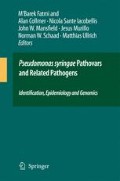The plant pathogenic bacterium Pseudomonas syringae pv. glycinea PG4180 synthesizes high levels of the phytotoxin coronatine (COR) at the virulencepromoting temperature of 18°C, but only low amounts at 28°C, the optimal growth temperature. The temperature-dependent COR gene expression is regulated by a modified two-component system, consisting of the histidine protein kinase CorS, a response regulator, CorR, and a third functionally essential protein, CorP. We analyzed at the transcriptional and translational level the expression of corS and the cma operon involved in COR biosynthesis, after a temperature downshift from 28°C to 18°C. The synthesis of cma mRNA was induced within 20 min and then increased steadily and gradually in the 14 h following the shift to 18°C. The synthesis of corS mRNA was induced to a lesser extent by the temperature downshift. The induction of cma expression was a result of accelerated transcription rather than increased stability of the cma transcript at 18°C. Accumulation of the COR biosynthetic protein CmaB correlated with accumulation of cma mRNA. However, cma transcription was suppressed by inhibition of de novo protein biosynthesis.
Access this chapter
Tax calculation will be finalised at checkout
Purchases are for personal use only
Preview
Unable to display preview. Download preview PDF.
References
Aguilar, P.S., Hernandez-Arriaga, A.M., Cybulski, L.E., Erazo, A.C., and de Mendoza, D., 2001, Molecular basis of thermosensing: a two-component signal transduction thermometer in Bacillus subtilis. Embo. J. 20: 1681–1691.
Beier, D. and Gross, R., 2006, Regulation of bacterial virulence by two-component systems. Curr. Opin. Microbiol. 9: 143–152.
Bender, C.L., Stone, H.E., Sims, J.J., and Cooksey, D.A., 1987, Reduced pathogen fitness of Pseudomonas syringae pv. tomato Tn5 mutants defective in coronatine production. Physiol. Mol. Plant Pathol. 30: 273–283.
Bender, C.L., Liyanage, H., Palmer, D., Ullrich, M., Young, S., and Mitchell, R., 1993, Characterization of the genes controlling the biosynthesis of the polyketide phytotoxin coronatine including conjugation between coronafacic and coronamic acid. Gene 133: 31–38.
Bender, C.L., Alarcon-Chaidez, F., and Gross, D.C., 1999, Pseudomonas syringae phytotoxins: mode of action, regulation, and biosynthesis by peptide and polyketide synthetases. Microbiol. Mol. Biol. Rev. 6: 266–292.
Budde, I.P. and Ullrich, M.S., 2000, Interactions of Pseudomonas syringae pv. glycinea with host and nonhost plants in relation to temperature and phytotoxin synthesis. Mol. Plant Microbe Interact. 13: 951–961.
Budde, I.P., Rohde, B.H., Bender, C.L., and Ullrich, M.S., 1998, Growth phase and temperature influence promoter activity, transcript abundance, and protein stability during biosynthesis of the Pseudomonas syringae phytotoxin coronatine. J. Bacteriol. 180: 1360–1367.
Calva, E. and Oropeza, R., 2006, Two-component signal transduction systems, environmental signals, and virulence. Microb. Eco. 51: 166–176.
Couch, R., O’Connor, S.E., Seidle, H., Walsh, C.T., and Parry, R., 2004, Characterization of CmaA, an adenylation-thiolation didomain enzyme involved in the biosynthesis of coronatine. J. Bacteriol. 186: 35–42.
Dunleavy, J., 1988, Bacterial, fungal, and viral diseases affecting soybean leaves, p. 40–46. In T.D. Wyllie and D.H. Scott (eds), Soybean Diseases in the North Central Region. American Phytopathological Society, St. Paul, MN.
Graumann, P. and Marahiel, M.A., 1996, Some like it cold: response of microorganisms to cold shock. Arch. Microbiol. 166: 293–300.
Hurme, R. and Rhen, M., 1998, Temperature sensing in bacterial gene regulation – what it all boils down to. Mol. Microbiol. 30: 1–6.
Palmer, D.A. and Bender, C.L., 1993, Effects of environmental and nutritional factors on production of the polyketide phytotoxin coronatine by Pseudomonas syringae pv. glycinea. Appl. Environ. Microbiol. 59: 1619–1626.
Palmer, D.A. and Bender, C.L., 1995, Ultrastructure of tomato leaf tissue treated with the pseudomonad phytotoxin coronatine and comparison with methyl jasmonate. Mol. Plant-Microbe Interact. 8: 683–692.
Rangaswamy, V. and Bender, C.L., 2000, Phosphorylation of CorS and CorR, regulatory proteins that modulate production of the phytotoxin coronatine in Pseudomonas syringae. FEMS Microbiol. Lett. 193: 13–18.
Smirnova, A. and Ullrich, M., 2004, Topological and deletion analysis of CorS, a Pseudomonas syringae sensor kinase. Microbiology 150: 2715–2726.
Smirnova, A., Li, H.Q., Weingart, H., Aufhammer, S., Burse, A., Finis, K., Schenk, A., and Ullrich, M.S., 2001, Thermoregulated expression of virulence factors in plant-associated bacteria. Arch. Microbiol. 176: 393–399.
Stock, A.M., Robinson, V.L., and Goudreau, P.N., 2000, Two-component signal transduction. Annu. Rev. Biochem. 69: 183–215.
Suzuki, I., Los, D.A., Kanesaki, Y., Mikami, K., and Murata, N., 2000, The pathway for perception and transduction of low-temperature signals in Synechocystis. Embo J. 19: 1327–1334.
Tamura, K., Zhu, Y., Sato, M., Teraoka, T., Hosokawa, D., and Watanabe, M., 1998, Role of coronatine production by Pseudomonas syringae pv. maculicola for pathogenicity. Ann. Phytopathol. Soc. Japan 64: 299–302.
Thieringer, H.A., Jones, P.G., and Inouye, M., 1998, Cold shock and adaptation. Bioessays 20: 49–57.
Ullrich, M., Penaloza-Vazquez, A., Bailey, A.M., and Bender, C.L., 1995, A modified two-component regulatory system is involved in temperature-dependent biosynthesis of the Pseudomonas syringae phytotoxin coronatine. J. Bacteriol. 177: 6160–6169.
Weingart, H., Stubner, S., Schenk, A., and Ullrich, M.S., 2004, Impact of temperature on in planta synthesis of the Pseudomonas syringae phytotoxin coronatine. Mol. Plant Microbe Interact. 17: 1095–1102.
Author information
Authors and Affiliations
Editor information
Editors and Affiliations
Rights and permissions
Copyright information
© 2008 Springer Science + Business Media, B.V
About this chapter
Cite this chapter
Braun, Y., Smirnova, A., Ullrich, M. (2008). Impact of Temperature on the Regulation of Coronatine Biosynthesis in Pseudomonas syringae . In: Fatmi, M., et al. Pseudomonas syringae Pathovars and Related Pathogens – Identification, Epidemiology and Genomics. Springer, Dordrecht. https://doi.org/10.1007/978-1-4020-6901-7_17
Download citation
DOI: https://doi.org/10.1007/978-1-4020-6901-7_17
Publisher Name: Springer, Dordrecht
Print ISBN: 978-1-4020-6900-0
Online ISBN: 978-1-4020-6901-7
eBook Packages: Biomedical and Life SciencesBiomedical and Life Sciences (R0)

